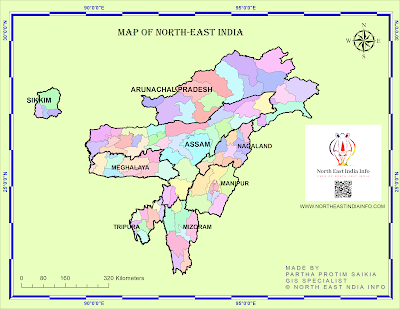Northeast India is the easternmost region of India. Northeast India because of its locational isolation has remained a terra incognita even after more than a half-century of attainment of independence by the country.
Northeast India is located between 200 N latitude to 290 30/ N latitude and 890 46/ E longitude to 970 30/ E longitude.
Its northern and eastern boundaries are natural barriers represented by the high Himalayan Mountain and Patkai Hill range respectively. However, its southern and western boundaries are more political than natural.
 |
| People of Northeast India |
Northeast India is commonly called the land of ‘Seven-Sisters’. Of the present seven states, viz Arunachal Pradesh, Assam, Nagaland,
Meghalaya, Mizoram, Manipur and Tripura, The first five were parts of undivided
Assam, from the viewpoint of administration, during the pre-independence
period.
They were subsequently constituted into individual states to fulfill the
socio-political aspirations of the people inhabiting them. Manipur and
Tripura, on the other hand, were princely states which become group c states after
independence and later become full-fledged states. After the addition of Sikkim people
also referred to Sikkim as a 'brother state'.
The Region
Northeast India is surrounded by hills and mountains on
three sides. It is only towards the west the region is bordered by plains. But
at the time of attainment of independence in 1947, the country was so
partitioned that the eastern part of the then Bengal was constituted into East
Pakistan (now Bangladesh). This makes almost isolated the northeastern part of
India from the rest of the country, except
the Siliguri Corridor in West Bengal, with a width of 21 to 40
kilometers (13 to 25 mi) connects the North Eastern Region with East India.
The region consists of Assam, Arunachal Pradesh, Manipur,
Meghalaya, Mizoram, Nagaland, Tripura and Sikkim. The region has a population
of 389.84 lakh that is 3.79 percent of the total population of India. The
region has vast coverage of forest nearly 55 percent of the total
geographical area.

Boundary
The region shares an international border of 5,182
kilometers (3,220 mi) (about 99 percent of its total geographical boundary)
with the neighboring countries – 1,395 kilometers (867 mi) with Tibet
Autonomous Region, China in the north, 1,640 kilometers (1,020 mi) with Myanmar
in the east, 1,596 kilometers (992 mi) with Bangladesh in the south-west, 97
kilometers (60 mi) with Nepal in the west and 455 kilometers (283 mi) with
Bhutan in the north-west.
It comprises an area of 262,230 square kilometers
(101,250 sq. mi), almost 8 percent of that of India, and is one of the largest
salient (panhandles) in the world. The states of North Eastern Region are
officially recognized under the North Eastern Council (NEC), constituted in
1971 as the acting agency for the development of the northeastern states. Long
after induction of NEC, Sikkim formed part of the North Eastern Region as the
eighth state in 2002. India's Look-East connectivity projects connect Northeast
India to China and ASEAN.
Geology
Northeast India is geologically a very complex region since
it represents the dynamic frontal part of the Indian plate on the one hand and
the relatively stable central (Chinese) plate on the other. in between these
two plates there lay the organically active bed of the Tethyan Geosyncline with
it's fore deep skirting the dynamic Indian plate. The Geological history of the
region directly or indirectly involves almost all the major geological age from
the Precambrian to the recent.
The shilling Plateau and the Karbi Hills being
part of the Gondwanaland are Archaean or Pre-Cambrian in age. In its northward
movement, a part of Gondwana massif (also termed as the Indian plate) exerted
pressure on the geologically Tethyan
belt, which is pressed by the plate in the south and west and by Chinese
plate in the north and northeast, took a syntaxial bend along what is today
Dibang- Lohit Hills. The whole geosyncline belt representing the Arunachal
Himalayan and quaternary in the course of Himalayan orogeny in the late
Tertiary and Quaternary periods. Thus, geological bends ranging from
Pre-Cambrian to recent periods can be found scattered in the region.
Physiography
Northeast India may be divided into the following
physiography divisions and subdivisions
1. The Plateaus
1.1 Meghalaya
plateau,
1.2 Karbi plateau.
2. The Hills and Mountains:
2.1 Himalayan
Mountainous Region,
2.2 The eastern and
southern Patkai-Purvanchal Hills:
3. The Plains:
3.1 Brahmaputra
Plain
3.2 Barak Plain
3.3 Manipur Plain
3.4 Tripura Plain
1. The Plateaus Region:
The hard crystalline massif forming the core of the region
is, in fact, an extension of the Deccan plateau. The latter extends underground
form the Rajmahal Hills of Chotanagpur Plateau below Malda Districts of West
Bengal and Rajshihahi, Dinajpur and Rangpur Districts of Bangladesh and appears
in the Northeast above the surface as Meghalaya Plateau and Karbi Hills.
2. The Hills and Mountains:
The second major physiographic unit of Northeast India,
consists of hills and mountains. This unit stretches from the Bhutan Himalaya,
covering the northern part of the region and then turning southward, covers its
eastern and southern parts.
3. The Plains:
There are four important plains in North-East India, viz.
the Brahmaputra Plain (54315 square kilometers), the Barak Plain (6962 square
kilometers), the Manipur Basin (1843 square kilometers), and the Tripura
Piedmont Plain (3500 square kilometers)
Climate
Northeast India displays, to a large extent, the character
of the tropical climate, especially in the valleys. There are three seasons in the
area, winter, summer and rainy season, though the rainy season, as in the rest of
India coincides with summer months. There is a climatic contrast between the
valleys and the mountainous region. The summer temperatures in the plains vary
between 30 and 33 °C, while the hills have a mean summer temperature of around
20 °C with a mean minimum of 15 °C. Nowhere in the region, there is heavy snow
except in the higher parts of Arunachal Pradesh, like west Kameng and Tawang
areas. No part of North-East India receives rainfall below 1,000 mm.
Climate Features and Factors of Northeast India
1. The situation of the hills, plateau and mountains in the
regions.
2. The seasonal change in the pressure condition over the
Bay of Bengal on the one hand and over the north-western landmass on other.
3. The tropical oceanic air-masses that blow over this
region.
4. Occasional visit of the westerly lows in winter.
5. Presence of local mountain and valley winds.
6. Presence of numerous vast water bodies and extensive
forests and development of local cyclones.
Economy and Industrialization
The economy of North- East India has got its definite
identity due to its peculiar physical, economic and socio-cultural characteristics.
This region consists of eight states viz., Assam, Arunachal Pradesh, Manipur,
Meghalaya, Mizoram, Nagaland, Tripura, Sikkim. The NER of India covers an area
of 2.62 lakh sq.km. It accounts for 7.9% of the total geographical area of the
country. With a total population of 39 million (2001), it accounts for 3.8% of the total population of India.
There are differences among the eight states in the North
Eastern region with respect to their resource endowments, level of
industrialization as well as infrastructural facilities. The industrial sector
has mainly grown around tea, petroleum (crude), natural gas etc. in Assam and
mining, sawmills and steel fabrication units in other parts of the region. The
full potential of the region is yet to be exploited and this has left the
economy in a primarily agrarian state.
Industrially, the NER continues to be the most backward
region in the country and the states in the region hardly have any industrial
base, except perhaps Assam, because of its traditional tea, oil and wood-based
industries.To some extent Meghalaya has made some headway in setting up of
small and medium industries. (Source- KKHSOU)
There are a number of factors contributing to the lack of industrial growth in the region like-
- Poor infrastructure
- Inadequate electricity supply
- Violence and extortion.
- Shyness of capital due to the high cost of production
- Vulnerability of the region
- Lack of entrepreneurial motivation on the part of the local people
- Low level of public sector investment, etc. In recent years the “Look East Policy” of Government of India has made North East more important and strategic. The region has to gear up to take up more challenges and capitalize on the opportunities thrown open by the huge market in the South East Asian Countries.
The industries of this region can be broadly classified as under:
- Agro-based industries: It includes tea industry, sugar
industry, grain mill products industry (rice, oil and flour mills), food
processing industry and the textile industry
- Mineral-based industries: Mineral-based industries of the north-eastern region include railway workshops, engineering industry, and re-Rolling Mills, steelworks, motor-vehicle workshops, galvanized wire units, cycle factories, aluminum utensils industry, cycle spare parts, steel wire net, barbed wire, cement industry etc. Moreover, the non-metal based industries include the petroleum oil industry and natural gas-based industry.
- Forest-based industries: It includes the plywood industry,
saw-mill industry, paper and paper pulp industry, match industry, letter
industry, hardboard industry etc.
- Other industries: It includes power generation industry,
fertilizer industry, printing press, brick and tiles industry, Ice industry,
chemical industry etc.
The industries of the north-eastern region can also be classified into (a) organized industries and (b) unorganized industries.
The organized industries of the north-eastern region include tea, petroleum, paper, cement, plywood, coal, jute, sugar, fertilizer etc.
Demography
The total population of Northeast India is 46 million with
68 percent of that living in Assam alone. Assam also has a higher population
density of 397 persons per km² than the national average of 382 persons per
km². The literacy rates in the states of the Northeastern region, except those
in Arunachal Pradesh and Assam, are higher than the national average of 74
percent. As per the 2011 census, Meghalaya recorded the highest population growth
of 27.8 percent among all the states of the region, higher than the national
average at 17.64 percent; while Nagaland recorded the lowest in the entire
country with a negative 0.5 percent.
Culture
The North East is a magnificent & tragic tapestry of
people, events & nature. You can be touched by its rivers, rain & mist,
overwhelmed by the seeming gentleness of its people & stirred by its
powerful & evocative history. There are not less than 220 ethnic tribes in
the eight states comprising the region with a population of about forty million
people. There are communities with kin in the neighboring countries.
Resources
The region has a rich biodiversity, oil and natural gas,
coal, limestone, hydro potential and forest wealth. Given the peculiar Geo-political location, the region can develop cross-border markets, which are
likely to be more cost-effective for North East India’s surplus production than
the distant national markets. The region is famous for its exotic flora and
fauna. It is ideally situated to produce spices, fruit & vegetables, flowers
and herbs.
Therefore, North-East India can emerge as an exporter of
orchids, flowers, apple, orange, pineapples, spices, herbs, etc. to the South
East Asian Region. The vast array of aromatic plants of the region can be used
in aromatic industry for the manufacture of perfumes, incenses, etc. Rich
bio-diversity, heritage sites & ethnic beauty can make it a destination for
the tourists.
To study more about Northeast India, some books recommendation given below. These are also used as references for this article. So, I highly recommend you go through these books. For details click the book title.
Best Books for Northeast India Geography :
